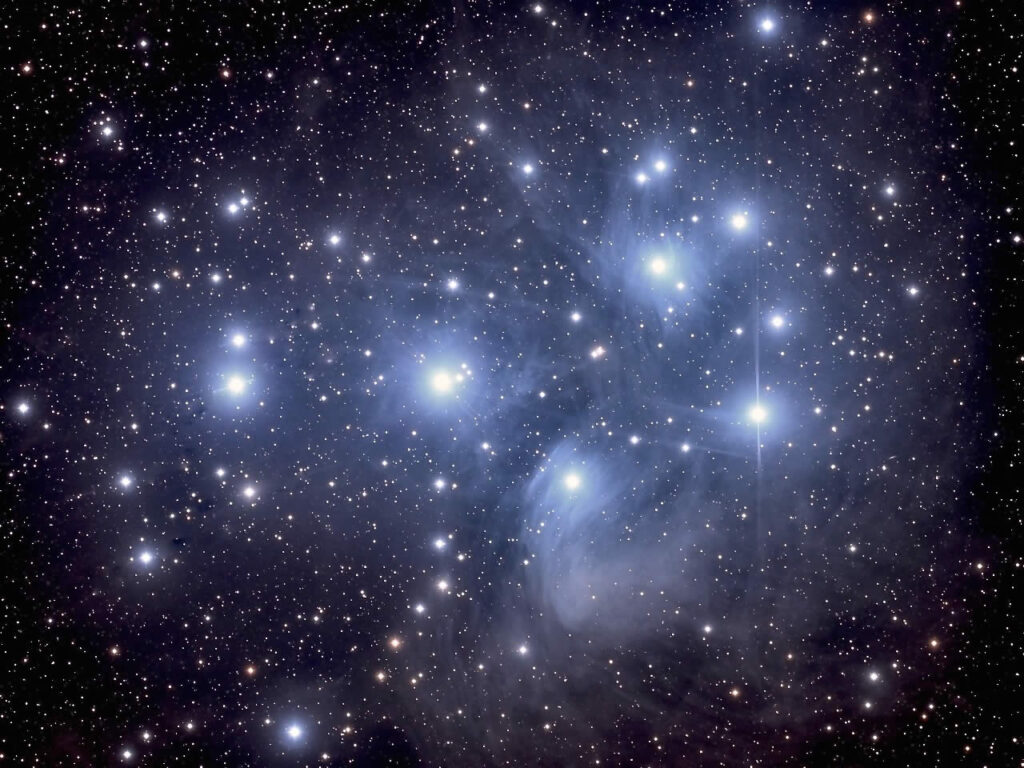Reminiscent of Van Gogh's "Starry Night" is this 3-hour image of a nearby star cluster commonly known as the Pleiades or "Seven Sisters." The cluster is prominent in the Fall and Winter sky as a small fuzzy area that resolves into 6-10 stars upon closer examination. The Pleiades is a spectacular cluster in binoculars or a low power telescope. The blue nebulosity surrounding the stars is a "reflection nebula." This kind of nebula is caused by light from one or more background stars passing through a cloud of dust along our line of sight. The light is reflected or "scattered" by microscopic dust particles.
British physicist Lord Raleigh first described this effect in the late nineteenth century. It is called "Raleigh scattering" in his honor. Raleigh discovered that light is scattered by particles that are smaller than the wavelength of the light. Light having a longer wavelength than the size of the intervening particles will pass through undisturbed. This means that small atoms and molecules scatter short-wavelength light (blue and violet) and let longer wavelengths (red, orange, yellow, green) pass through undisturbed. In this image, the intervening dust cloud consists mostly of carbon atoms whose small size only scatters blue light.
It is interesting to note that this same phenomenon (Raleigh scattering) is what makes the sky blue. Think of this incredible connection as you study this image. The bluish color you see surrounding these stars 450 light years away is caused by the same effect that makes our sky blue. In our case, nitrogen atoms in the upper atmosphere are small enough to effectively scatter only blue (short wavelength) light. It should also be noted that larger molecules will scatter all wavelengths of light equally, resulting in white light. This effect is observed whenever you drive a car at night into dense fog. The large water molecules effectively scatter all wavelengths of visible light from your car's headlights, resulting in the whitish illumination of the fog.
The Pleiades is mentioned by countless writers throughout history, and has been called various names by different cultures. It is mentioned three times in the Bible:
Job 9:9: "He is the Maker of the Bear and Orion, the Pleiades and the constellations of the south."
Job 38:31-33: "Can you bind the beautiful Pleiades?"
Amos 5:8: "He who made the Pleiades and Orion, who turns blackness into dawn and darkens day into night, who calls for the waters of the sea and pours them out over the face of the land-the LORD is his name."
The Pleiades Star Cluster (M45) in Taurus
Date Taken:November 7, 2013
Location Taken: Conditions of Location: Equipment Used:Takahashi FSQ-106 apochromatic refractor, Paramount ME mount, SBIG STL11000 CCD camera with remote guide head connected to Takahashi Sky90 for autoguiding, Astrodon hydrogen-alpha filter, T-Point used for polar alignment (required for each imaging session due to my portable setup)
Processing Used:15 x 300 seconds luminance, 8 x 200 seconds RGB, guided, 1x1 binning, processed in Maxim DL and Photoshop (total exposure 2.5 hours)
Distance from Location:450 light years
Constellation:Taurus
Other Link:

Very nice picture!